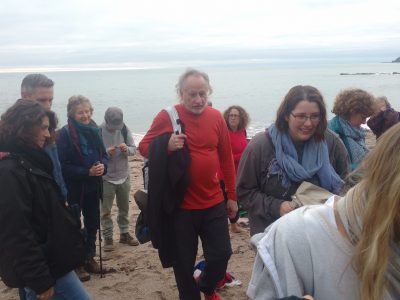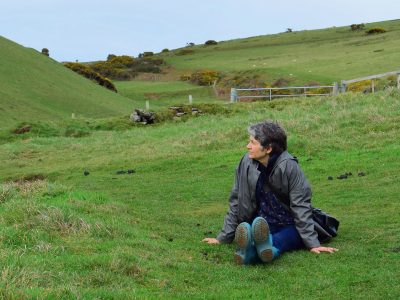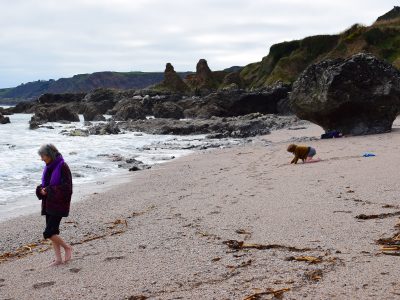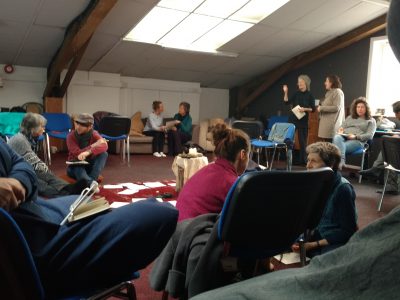Entangled with the World
The fire hissed softly as another piece of coal collapsed into white ash, overcome by the steadying flames. Still African to my bones, and quite used to warmer climates, I was grateful for the heat the juvenile bonfire emitted. But even its heat was no match for the wintry sternness and eeriness of the ‘Wodge,’ Schumacher’s Forest School site in Northwoods, Dartington. Except for the amber glow that danced uneasily across the faces of the cohorts in the circle, the whole place was dark and silent, with only tall proud trees and the bits of sky that fell through their interconnecting branches that bore witness to this hushed ring of seekers.
Fire. Witnessing trees. A desperate chill. And a whiff of collective madness. These were the elements that ordained this mysterious circle of 17 persons.
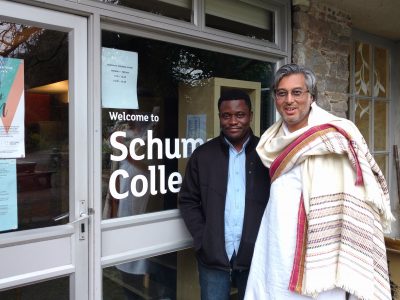
Manish signalled to me that it was time, so I went first—not before telling the group that one of the edges we had to explore in the days ahead was disgust, and how the things we feel repulsed by hold clues about the kinds of social-material frameworks we already inhabit. I then sat on a log of wood, raised my head to meet Manish’s gaze, and held out my hands as one would do when making supplication to the gods above. For what I was about to receive in return for my prayerful gesture, the moment was thick with perverse irony. Clad in a camo winter jacket, awkward head gear, and a blanket-scarf, Manish stirred the contents of the white ceramic bowl with his fingers, scooped up a generous amount, and pressed it on my face—covering my forehead, my cheeks, my chin, and nose with the stuff. He asked the circle to make a clicking sound with their tongues as I—and others after me—received this blessing. This anointing of sorts. I closed my eyes as the cold grimy mixture kissed my skin. When he was done, he placed a huge lump of the stuff between my cupped palms.
It was cow shit. Glorious cow shit. Green, brown, wild, and overpoweringly alive. We had obtained a fresh bucketful a farm away, mixed it with neem leaves and the spirit of a bonfire. Now it was on my face, like bees on a jar of honey. I stood up and retook my place in the circle. An hour or so later, we were all covered in shit (except two students who opted out for personal reasons), our faces a mishmash of toothy grins and green grime. The jokes came easy (“This is some good shit!,” “We are having a bit of a shit-uation here!”) and then we shared stories and wise sayings in the womb of the forest as the shit dried up and stiffened our faces, so that many of us could hardly talk. I looked around, taking in all the faces: given that we had advertised that session as a ‘cow dung ritual,’ it was amazing to me that everyone showed up. I had expected the students to scoff at some of the other processes we had earmarked for the week—‘Death Walk,’ ‘Powerful Questions,’ ‘Composting Ourselves,’ ‘Shop of the Open Heart’—but that didn’t happen.
Against all odds, here we were. There was something miraculous about being there together—snuggling together… black, white, brown, and freckled bodies—each endorsed by faecal matter in the presence of elder trees. Each an inexhaustible aspect of a world too wide that it—like a baobab tree—cannot be embraced or encircled.
On the opening night for the course, a day earlier, I had spoken of tortoise—a favourite African trickster figure who features prominently in most of our folk stories in West Africa—and his quest to gain all knowledge for himself. The story goes that when tortoise had scoured the world for all its wisdoms, he trapped them in an earthen gourd and attempted to hide it away for himself by tying it to the tip of a tall, majestic Iroko tree. The problem was short-limbed tortoise, with his gourd tied around his neck proving to be a formidable obstruction to his goal, could not get a grip on the tree—talk less of climbing it. He tried many postures, but the very thing he sought to hide away stood in his way. A grasshopper wandered by and cavalierly suggested to tortoise that he put the gourd on his back… then hopped away. Tortoise, now ashamed, figured his project of knowledge accumulation was already doomed from the start—“for wisdom seems to sprout from the most unusual places and in the most unexpected moments.” He climbed the tree and spilled the contents of the gourd into the world again.
Sitting with shit on our faces, holding shit-stained hands with the old and young, in a rhapsody of disgust, in a renunciation of our distance from the world, was our way of listening to grasshopper and of noticing that even the basest of things had things to say and teach that we may not have been ready for. Still, if anyone were to wander our way, they might have considered us witches or unearthly creatures of the night. And that would have made our rambunctious crew even merrier! This baptism, this immersion in things of the earth, in the compelling materiality of cow dung, here in the British town of Totnes, felt like a coming down to earth. Like homecomings and humiliation (if we take ‘humiliation’ to be a re-acquaintance with ‘humus’ or earth). It felt like a rite of passage for us moderns with weary feet, who had been exiled from the sensuous ground and its remarkable doings when we told ourselves the world did not matter.
The short course for Schumacher College was called “Radical Activism, Education and Emergence: Entangled with the World.” When designing the course, I had titled it differently: “The Deer will sing again! Radical Activism, Education and Emergence.” I had used Manish’s exact words for the first part of the title— words he had flippantly spat out during a ‘spiritual’ moment at an event we both attended in Switzerland years back. The way he shouted it in that room—and how it contrasted with the ‘seriousness’ of the event—had become an inside joke between us. It was only fitting that I used those words to highlight the trickster energies at the heart of the proposed course.
Our hosts at Schumacher College felt otherwise, believing that the title may have been too ‘poetic’ or ambiguous. So we came up with something different. What, however, remained unchanged in the transition between titles was the spirit of the course. A single troubling question: if we took seriously the proposition that the nonhuman world is alive—not just in a sense of being ‘aware’ but in the sense of having agency and making material contributions to the world’s emergence—what would change in our social change practices and in the ways we educate our children?
From that one question, many others were seemingly invoked: what if the ways we frame and meet our most troubling crises are part of the crises? What lingers in our blind spots, disturbing the supposed incontrovertibility of seeing? What are we missing? What questions are we not able to ask? What if we are not weird enough? And are there other spaces of power in partnership with the world—borne from other ways of relating with objects around us—that we can access?
Our sessions dove into the meat of these questions. With the majestic Toni Spencer—whose teachings, gentle facilitation, and red-haired midwifery of yearning and possibility granted a deeply appreciated authenticity to our explorations—and Gaby Franco, whose equally invaluable facilitation made an expansive space feel even airier and hospitable, Manish and I traced out a genealogy of ideas and interdisciplinary trends that are now placing emphasis—a post-human emphasis, mind you—on what the world is doing, as opposed to what we humans are doing to it. In short, we seem to have lost our place as the central concern of the universe—a truth that many pre-modern western and non-western societies never for once doubted.
Here are some of the ideas we explored.
We are literally and practically what the world is doing. Shifting from an analysis of modernity and its Cartesian precepts that situate the nonhuman as dumb, brute, and merely instrumental to our discussions and plans, to an analysis of the postmodern over-emphasis of story and consciousness, we articulated one of the many iterations of a ‘new materialism.’ Our thesis: the world around us isn’t some dead thing or mere container for human activity. In a sense that still leaves my chest expanded, we are what our environment is doing—just like an electron is what an electromagnetic field is doing. Just like a wave is what the ocean is doing. As such, we are porous. We spill through—and the ‘outer’ world co-constitutes us.
We never act alone. This means we can no longer think of thought, of agency, memory, joy, choice, or grief as psychic events bottled up in the sealed chambers of mind. Agency—the power to make material effects—is not limited to human actors. We might suppose that intention precedes action, but some of our most consequential actions are quite unintended (think climate change and its troubling effects).
Causality is queer. One of the more stunning implications of thinking of the world as agentic are that our causality models are hardly adequate to explain how things emerge. The world doesn’t add up, it adds on. Two and two equal five. The world is threaded through with a lot more spontaneity and flow and movement than our conditioning allows us to notice.
Stories are not enough. The philosophies that promise us the power to ‘change the world’ if only we ‘change the story’ take their actuating premise from the idea that the world is merely story—nothing else. As such, we presume that if we lined up the right sentences and reconfigured our discussions, the world will skip in consonance with our narrative rhythms. But the world is not a collection of words or stories. The world is not just mind or ‘consciousness’ (as many well-meaning New Age groups are wont to believe); it is also matter—or better still, it is mind-matter. An entanglement of the discursive and the material. The world outside of us is not a virtual wasteland awaiting our programming. It also does things. It initiates. It objects. It refuses. It stands in the way. It experiments. And we do all these things not because we are specially endowed with the seed of sentience to the exclusion of all around us, but because the world makes it possible.
To illustrate this idea, I challenged the class to describe the colour red without using a metaphor or simile. After some had suggested ‘fire’ or ‘passion’ or something that was clearly incidental to the description of red, the exercise ended with not very much produced by way of actual responses. I then asked if they could imagine explaining red to someone blind from birth—so that he or she would be able to understand the descriptive essence of ‘red’ without the mere materiality of seeing ‘red.’ It felt impossible to do this—and I felt the class experienced this limitation in starkly somatic ways that left them scratching their heads. Words are not the be-all and end-all of the world; the world is doing something too—something that sometimes resists categorization.
Perhaps this is why many wild men, shaman-type healers in the so-called global south, refuse to answer some questions posed to them or offer a bewildering response. They know that even questions are material things, little critters with histories of their own that touch upon stone, stardust, rushing wind, and loamy soil. In short, a question is embodied and diffracted through spacetime. And when one arrives, it is not always appropriate to send it on its way quickly. One must play with it, toss it about, offer it a meal, and listen to stories of its pilgrimage. When it is ready, it might choose to go on its way.
Confusion as a resource. Answers are therefore not the opposites of questions, and they are not always useful. The questions we ask trigger the entire world. They are the world examining itself. Even more, the space between a question and an answer is not empty and void. It is troubled and littered with many obstacles, many beings, and many forces we are called to engage with but often avoid in our rush for answers. If we lingered longer than we are used to, if we strayed from the calculability of a course of action, if we saw ‘con-fusion’ as a mingling together instead of a fall from grace, we might happen upon more radical forms of change.
The times are urgent enough for us to slow down. Slowing down is not so much about reducing one’s speed as it is about noticing the others that often get lost in our practices of seeing. It is about seeing our seeing, examining our frameworks and plot points. Guest speakers (and dear friends of ours) Frédérique Apffel-Marglin and Charles Eisenstein shared powerful instances of the manner in which the world extends far beyond our calculations and our metrics. Frédérique, a distinguished professor of anthropology who left the university to focus on the life-giving wisdoms of plants in Peru, spoke (via Skype) about the benefits of bio-char —a way of combining carbonized biomass with soils that was inspired by and embedded in Peruvian indigenous practices of partnering with the earth. Bio-char (about which Frédérique has written in her new book, Sacred Soil) shows remarkable potentials for carbon sequestration and enriching soils, but—Frédérique warned—there is a danger of converting the technology into some kind of ‘green commodity,’ while shelving the deep practices and rituals of tending to the nonhuman world that occasioned it.
Charles followed in that stream of thought, sharing an acquaintance’s story about beekeeping practices that dispense with male bees or drones because they are considered useless to the process of honey production. His acquaintance revealed that she had, by some means, come to the knowledge that the male bees were not only not useless, but eminently valuable to the bee community. In a moment that drew gasps of awe from the class, Charles shared how the song of the male drones nurtured the next generation of bees, tending to them in ways that would have escaped the hard-nosed capitalist. Was this fluffy, sentimental stuff? Charles opined that there was a modern cynicism that cut out other aspects of the world’s vitality that did not coincide with our instrumentalist forms of engagement. What was important was coming to the edges and cultivating the skill of meeting the universe halfway—a universe surprisingly more sensuous and orgasmic than our linear models suggest.
Straddling the borders between what might have been received as a fluffy, politically stultifying notion of the world that reinforced white privilege and did not address the felt needs of at-risk communities and what might have been taken as a far-fetched doctrine without proper grounding in anything empirical, we sought to show how conditioned patterns of responding to challenges mostly serve to perpetuate the same. As children of the ‘less developed world,’ we grounded ourselves in the serious and sometimes painful life-worlds of our own people —and invited the class to see that when we spoke about sensuous causalities, entanglement, nonhuman agencies, post-human performances, and the possibility of different kinds of activisms (the many-streams instead of the mainstream, in Manish’s words), we were speaking with an urgency of our own. Our urgency, however, was followed by a slowing down—a vital coming to terms with a world that is just as much an actor in shaping the outcomes we often think are ours alone to contemplate.
With different open space explorations, free-wheeling conversations, an expedition to the Great Mattiscombe Beach, tearful encounters, moments of throbbing silence, hugs that didn’t want to be unravelled, difficult moments of uneasy tensions, games like ‘musical chairs’ (only this time, inverted! Figure it out!), and plenty of dancing, we came to edges of what it means to be ‘good,’ why not-knowing is just as sacred as knowing, and how our practices could be radically altered if we approached the world differently. We shared about our work with The Emergence Network and Swaraj University, demonstrating how we are walking our own decolonial paths to other spaces of power.
Perhaps one of the most striking moments of the week-long course was the Shop of the Open Heart, a practice embedded in gift culture that challenges accounts of ownership and privacy. Just as we had invited every student to come with an object that spoke to them, we also invited them to come with a valuable item they’d like to give away. On a table in the centre of the room we used for the lectures and exercises, the students assembled a queer admixture of books, a shark egg shell, clothes, a pair of boots, pictures of loved ones, and many other items I cannot quite recall. They weren’t mere items, as was demonstrated shortly after when we invited the students to ‘window-shop’ around the table and listen to what was calling to them, take a break, and then return to the table to pick up their chosen objects.
I looked around to see puddles of people wiping away free-flowing tears, while being attended to by other participants. I don’t want to ‘explain’ what happened, but I do reckon that the ‘intimacy of gift’ unclogged pores that were closed up as a result of long-established practices of ownership and separation. In listening to another tell the story of an object, we met each other in our most fragile places. We met the ‘other’ that is always a part of us—and we met our own strange souls as if for the first time.
The course was a beautiful time spent at the borderlands of the familiar. A coming down to earth. A hint of the kinds of activisms we can hold space for: activisms of the particular, activisms of skin and touch and tears and the eminence of a far-travelled question as well as the nobility of not-knowing how to craft an answer. The participants—whose precious names, touching wisdoms, and vibrant faces we will hold in our hearts—were present and alive in ways that were unique to and spoke of their individual life stories. I am deeply grateful that I crossed paths with them. And, speaking of crossing paths, could there be a better way to end this piece about the efficiency of bewilderment than recalling a conversation I had with a Yoruba priest?
“If you want to find your way, you must become lost. Generously so.”
I asked, “How does one become lost?”
He replied, “Shall I turn you into a goat?”

